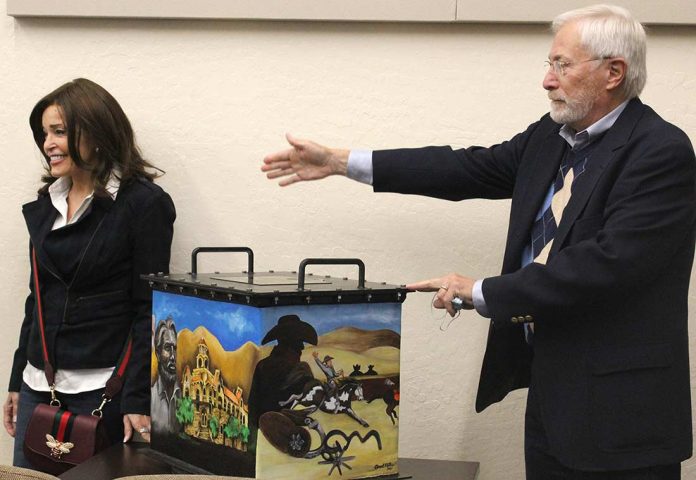
A week after Gilroy’s 150th anniversary time capsule was unveiled, the city council chambers were filled with shouting audience members and a split number of people either showing up to support the artist or question the decision behind the artwork.
Since the time capsule was not on the Sept. 20 agenda, the council did not discuss the issue in depth. However, in response, it did agree to discuss at a future meeting a policy regarding displaying gifts, as well as possibly taking the time capsule out of public view until a supplemental piece of artwork that incorporates “diversity and inclusion” is completed.
On Sept. 13, Gilroy’s Sesquicentennial Committee unveiled a time capsule filled with items that signified 2020 in Gilroy, marking 150 years since it was incorporated as a city on March 12, 1870. The capsule includes a street banner, copies of the 2040 General Plan and county shelter-in-place order, photos of the city council and local newspapers, among other items.
Gilroy artist Carol Peters painted the capsule. Each side of the capsule features iconic people and places from Gilroy’s history, including Old City Hall, cowboy Casey Tibbs and his horse Warpaint, two of the Gilroy Garlic Festival’s founders, Don Christopher and Val Filice, and more.
But during the council’s comment period after the unveiling, Councilmember Rebeca Armendariz said she was concerned about the capsule artwork’s “lack of diversity.”
“It seems like the committee had a good amount of members in it and you guys worked really hard,” she said. “But, what Gilroy looks like isn’t reflected there, and all the folks who also contributed to our beautiful town.”
Armendariz’s comments set off a social media firestorm that spilled over to the Sept. 20 council meeting, with many people agreeing with her, while others said her remarks were uncalled for and demanded her resignation.
Peters said she was heartbroken over the controversy the artwork generated.
When given the task to paint the capsule, Peters admitted it was “mind-boggling” when she tried to figure out how she could fit every person of influence in Gilroy’s history on the box.
Instead, Peters said she realized the capsule was meant as a celebration, and she turned to events and places such as the Garlic Festival and Gilroy Gardens that bring people of all cultures together.
She said she felt that Armendariz’s comments were directed at her.
“I appreciate everyone’s opinions and would’ve gladly incorporated suggestions into the design prior to painting,” she said. “After the comment, I did not feel good. I felt I had let the city, the committee and everyone down. I felt very sad and confused. Why hadn’t I had criteria prior to painting? Why was this criticism coming out for the first time in the council chambers?”
Amanda Rudeen, chair of the sesquicentennial committee, said no direction was given to Peters, “as we were confident she would create something beautiful, which she has.”
“It was not meant to offend anybody,” she said. “It was a gift. That’s all it was.”
Valentin Lopez, chair of the Amah Mutsun Tribal Band, said the process behind choosing the artwork “ignored” the indigenous people who have lived on the land for generations.
“This is an important project, and all people need to get included,” he said. “We need to recognize that people cannot be ignored, cannot be forgotten or erased, and that includes the Amah Mutsun.”
At a future meeting, the council is expected to discuss a policy on displaying gifts at City Hall. It will also discuss an inclusion policy for all boards and commissions, as well as a possible supplemental piece of artwork to be displayed with the capsule.
On a request from Armendariz, the council will also discuss removing the capsule from the chambers until the artwork is “reflective” of Gilroy’s diversity.
“I don’t want a separate but equal time capsule,” she said. “I don’t want us to install separate water fountains. I want us to have one unified box that reflects Gilroy.”
Councilmember Carol Marques reiterated that the capsule is a “gift.”
“I’ve been raised not to insult a person who is giving me a gift, whether I liked it or not,” she said. “That was not for me to say publicly. Carol did this for free. If you are asking for her to add or replace, then we better start thinking how we are going to pay her, because I highly doubt she’s going to do another piece for free.”












